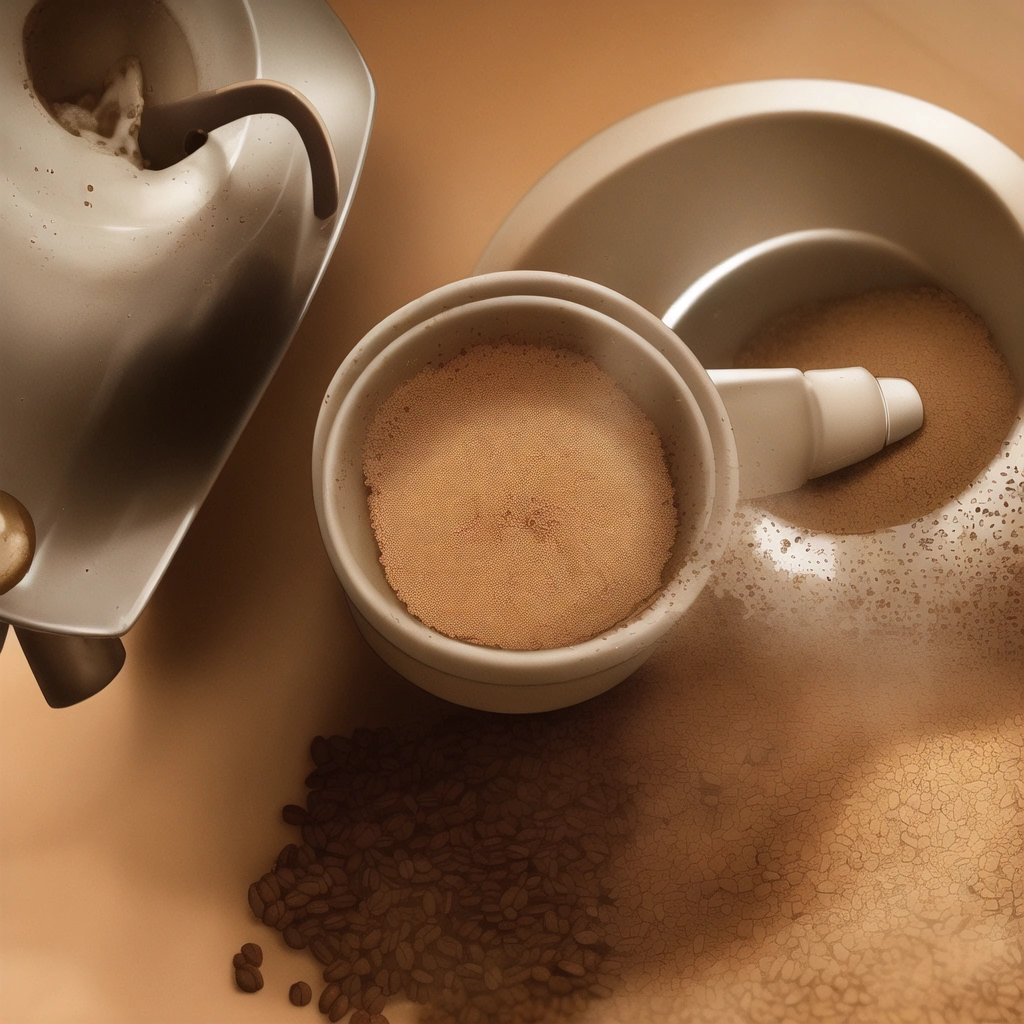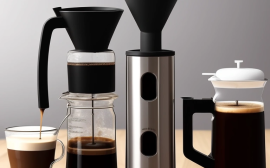Introduction: The Grind Matters
The aroma of freshly ground coffee beans is a siren’s call for any coffee lover, a promise of the rich, complex flavors to come. But achieving that perfect brew, the one that dances across your palate and invigorates your senses, goes far beyond simply selecting quality coffee beans. It requires mastering the art of coffee grinding, a skill often overlooked but utterly essential to unlocking the full potential of your chosen roast. This comprehensive coffee guide delves into the nuances of home coffee grinding, providing you with the knowledge and techniques to elevate your daily coffee ritual from a mundane routine to a moment of pure, unadulterated pleasure.
We’ll explore the crucial role grind size plays in extraction, the differences between burr grinder and blade grinder options, and how to fine-tune your grinding process for optimal results. Think of coffee beans as tiny vaults, each containing a universe of aromatic compounds and flavor notes just waiting to be released. Coffee grinding is the key that unlocks these vaults, creating the surface area necessary for hot water to perform its extraction magic during coffee brewing.
The consistency and evenness of your coffee grinding directly impacts the final taste. For example, imagine using pre-ground coffee that has sat on a shelf for weeks; the volatile oils, responsible for much of the coffee’s aroma and flavor, have already dissipated, leaving you with a dull, lifeless cup. Freshly grinding your own coffee beans ensures that these precious oils are preserved, delivering a vibrant, nuanced brew every time. One of the first steps in mastering coffee grinding is understanding the impact of grind size.
Different coffee brewing methods demand different grind sizes to achieve optimal extraction. A coarse grind, resembling sea salt, is ideal for methods like the French press, where the coffee grounds steep in hot water for an extended period. A medium grind, similar to coarse sand, is well-suited for drip coffee makers and pour-over methods, allowing for a balanced extraction. A fine grind, like powdered sugar, is essential for espresso, where high pressure forces hot water through the compacted coffee grounds in a matter of seconds.
Using the wrong grind size can lead to under-extraction (sour, weak coffee) or over-extraction (bitter, harsh coffee), highlighting the critical role grind size plays in the final cup. Selecting the right coffee grinder is another crucial element in your home brewing journey. The two primary types of grinders are burr grinders and blade grinders, each with its own set of advantages and disadvantages. Burr grinders, which use two revolving abrasive surfaces to crush coffee beans between them, offer a consistent and uniform grind size, essential for even extraction and a balanced flavor profile.
Blade grinders, on the other hand, use a spinning blade to chop the beans, resulting in an uneven grind with a mix of fine particles and large chunks. While blade grinders are generally more affordable, the inconsistent grind they produce can lead to unpredictable and often disappointing results. Investing in a quality burr grinder, whether conical or flat burr, is a worthwhile investment for any serious home coffee enthusiast. Ultimately, mastering the art of coffee grinding is a journey of experimentation and refinement.
Start by researching the recommended grind size for your preferred brewing method and then adjust based on your taste preferences. Pay close attention to the brewed coffee: is it too bitter? Go coarser. Too sour? Go finer. Keep a coffee journal to track your grind settings, coffee bean types, and brewing parameters. This will allow you to consistently replicate your favorite brews and fine-tune your technique over time. Regularly cleaning your best coffee grinder and, if necessary, calibrating it ensures consistent performance and prevents the buildup of oils and residue that can negatively impact the taste of your coffee. By embracing this process of continuous learning, you’ll unlock the full potential of your coffee beans and elevate your home brewing experience to new heights.
Understanding Grind Size and Its Impact
Grind size significantly impacts the extraction rate and flavor of your coffee, acting as a gatekeeper to the nuanced flavors locked within your beans. The size of the grounds determines the surface area exposed to water during brewing, directly influencing how quickly and thoroughly the coffee’s essence is extracted. A coarse grind, resembling coarse sand, is ideal for immersion brewing methods like French press, allowing for a full-bodied, robust brew with a heavier mouthfeel. The longer brew time associated with French press necessitates larger particles to prevent over-extraction and bitterness.
Imagine steeping tea leaves – larger leaves require longer steeping times than finer particles. Similarly, coarse coffee grounds require the longer brew time of a French press to fully develop their flavor profile. Conversely, a fine grind, with a texture akin to table salt, is essential for espresso. The rapid, high-pressure brewing process of espresso demands a fine grind to ensure sufficient extraction within the short brew time. A medium grind, falling somewhere between coarse sand and table salt, suits drip and pour-over methods, striking a balance between brew time and extraction.
This versatile grind size allows for a balanced cup, showcasing the coffee’s brighter notes and subtle complexities. Too coarse a grind in these methods will result in a weak and sour brew, as the water rushes through the grounds without extracting sufficient flavor compounds. Too fine, and the coffee will be bitter and over-extracted, the water lingering too long and drawing out undesirable flavors. Understanding these nuances is crucial for brewing mastery. Choosing the correct grind size is akin to choosing the correct paintbrush for a painting – each size yields a different result.
The interplay between grind size and brewing method unlocks the full potential of your coffee beans, transforming them from mere ingredients into an exquisite sensory experience. For instance, a light roast Ethiopian Yirgacheffe, known for its delicate floral and citrus notes, will benefit from a medium-fine grind in a pour-over, allowing these nuanced flavors to shine. However, the same beans ground coarsely for French press might yield a muddled cup, obscuring the inherent brightness. Similarly, a dark roast Sumatran Mandheling, with its earthy and chocolatey profile, might thrive as a coarse grind in a French press, emphasizing its body and richness. Experimentation is key; a burr grinder, with its adjustable settings, empowers you to explore the spectrum of grind sizes and discover the optimal setting for each bean and brewing method. This hands-on approach, coupled with careful observation of the brewed coffee’s aroma, taste, and body, allows you to fine-tune your technique and consistently achieve coffee perfection at home.
Grinder Types: Burr vs. Blade
Choosing the right grinder is paramount for any home brewing enthusiast. Burr grinders, whether conical or flat, offer a consistent particle size, which is essential for even extraction and a balanced flavor profile in your coffee. Blade grinders, while more affordable upfront, produce uneven grinds, leading to inconsistent results – some particles are too fine, creating bitterness, while others are too coarse, resulting in sourness. Consider your budget and desired brewing methods when selecting a grinder.
Burr grinders, while a higher initial investment, provide a significant upgrade in grind quality and, ultimately, flavor, making them a worthwhile investment for serious coffee lovers. For example, a consistent grind is especially crucial for espresso, where even slight variations can drastically affect the shot’s quality. Burr grinders come in two primary types: conical and flat burr grinders. Conical burr grinders feature a cone-shaped burr that rotates inside a ring-shaped burr. They tend to be quieter and produce less heat during grinding, which helps preserve the delicate aromas of the coffee beans.
Flat burr grinders, on the other hand, use two parallel, ring-shaped burrs. They often grind faster and can produce a more uniform particle size, though they may generate more heat. The choice between conical and flat burr grinders often comes down to personal preference and budget, as both offer a significant improvement over blade grinders for coffee grinding. Many coffee aficionados find flat burr grinders ideal for single-origin coffees where clarity of flavor is paramount.
Blade grinders, often resembling small food processors, operate by chopping the coffee beans with spinning blades. While they are inexpensive and readily available, their inconsistent grind size makes it difficult to achieve optimal extraction. The resulting coffee often tastes muddy or bitter due to over-extraction of the finer particles, while the larger particles contribute to sourness. While blade grinders might suffice for occasional coffee drinkers, those seeking to truly master home brewing and unlock the potential of their coffee beans should consider upgrading to a burr grinder.
Think of it like this: a blade grinder is like using a dull knife to chop vegetables – you’ll get the job done, but the results won’t be pretty. For those just starting their coffee journey, a manual burr grinder can be an excellent entry point into the world of consistent coffee grinding. These grinders require a bit more effort, but they are often more affordable than electric burr grinders and allow for greater control over the grind size.
Manual grinders are also a great option for travel or camping, as they don’t require electricity. As your passion for coffee brewing grows, you might consider investing in an electric burr grinder, which offers greater convenience and speed, especially when grinding larger quantities of coffee beans. Ultimately, the best coffee grinder is the one that consistently produces the grind size that suits your preferred brewing method and taste preferences. When evaluating different burr grinders, consider factors such as grind adjustment settings, motor power (for electric models), and ease of cleaning.
A wider range of grind settings allows you to fine-tune your grind size for different brewing methods, from coarse for French press to fine for espresso. A more powerful motor will ensure consistent grinding speed, especially when grinding larger quantities of beans. And a grinder that is easy to disassemble and clean will help maintain its performance and longevity. Remember, proper maintenance is key to ensuring your coffee grinder continues to deliver consistent, high-quality grinds for years to come. Regularly cleaning your grinder prevents the buildup of coffee oils, which can affect the taste of your coffee.
Grind Adjustment and Calibration
“Grind Adjustment and Calibration: The Path to Coffee Nirvana” Dialing in your grind is not merely a step in coffee preparation; it’s a journey of experimentation and discovery, a pursuit of coffee nirvana. It’s the process of fine-tuning your grinder’s settings to achieve the optimal particle size for your chosen brewing method and taste preferences. This journey begins with understanding the recommended grind size for your brewing method, serving as a starting point for your personalized adjustments.
A French press, with its immersion brewing, thrives on a coarse grind, allowing the larger particles to fully unfurl their complex flavors over a longer steeping time. Drip coffee makers, on the other hand, typically prefer a medium grind to balance extraction time with the water flow rate. Espresso, with its rapid, pressurized brewing, demands a fine grind to extract the full spectrum of flavors in a short burst. Once you have a baseline, the real magic begins.
Brew a cup and critically assess the result. Is it too bitter? Bitterness often indicates over-extraction, meaning the water has spent too much time in contact with the grounds, drawing out undesirable compounds. Adjust your grinder to a coarser setting, increasing the particle size and reducing the surface area exposed to the water. This will shorten the extraction time and mellow the bitterness. Conversely, if your brew is too sour, it suggests under-extraction. The water has passed through the grounds too quickly, failing to capture the full range of desirable flavors.
Fine-tune your grinder to a finer setting, decreasing the particle size and increasing the surface area for the water to interact with. This will lengthen the extraction time and balance the acidity. Remember, small adjustments are key. Move the grind setting by one increment at a time, brewing and tasting after each adjustment until you reach your ideal flavor profile. Beyond taste, observe the physical characteristics of your brewed coffee. A properly dialed-in grind will produce a balanced cup, free from excessive bitterness or sourness.
The crema on an espresso shot should be rich, thick, and persistent, a testament to the fine grind and proper extraction. In a French press, the grounds should settle evenly at the bottom, leaving a clear, clean cup. These visual cues provide valuable feedback in your quest for the perfect grind. Maintaining consistency in your grind is crucial for reproducible results. Regularly cleaning your grinder is paramount. Coffee oils and fine particles can accumulate over time, affecting the grinder’s performance and imparting stale flavors to your brew.
Disassemble your grinder according to the manufacturer’s instructions and clean all removable parts with a brush and warm, soapy water. Dry thoroughly before reassembling. Calibration, while less frequent, ensures that your grinder’s settings remain accurate. Many burr grinders offer calibration tools or procedures. Consult your grinder’s manual for specific instructions. By meticulously maintaining and calibrating your grinder, you’ll ensure that each cup of coffee is as exceptional as the last, a testament to your mastery of the art of the grind.
Investing in a high-quality burr grinder, whether conical or flat, is a worthwhile investment for any serious home brewer. Unlike blade grinders, which produce uneven particle sizes, burr grinders deliver consistent results, crucial for achieving the desired extraction and unlocking the full potential of your coffee beans. With consistent grinding, you lay the foundation for consistent brewing, allowing you to fully explore the nuances of different coffee beans and brewing methods. The journey of grind adjustment is a continuous loop of experimentation, observation, and refinement. Embrace the process, keep detailed notes of your adjustments and the resulting flavors, and don’t be afraid to experiment. Your palate is your ultimate guide, leading you toward the perfect cup, brewed precisely to your taste. With patience and persistence, you’ll not only master the technical aspects of grinding but also cultivate a deeper appreciation for the transformative power of this essential step in the coffee brewing ritual.
Conclusion: The Art of the Grind
By understanding the interplay of grind size, grinder type, and brewing method, you can unlock the full potential of your coffee beans and elevate your home brewing experience. It’s a journey of experimentation, tasting, and refining your technique, one that transforms the simple act of making coffee into an art form. The perfect cup is within your reach, waiting to be discovered through the mastery of the grind. Just as a painter carefully selects their brushes, a coffee aficionado must choose the right grind size and grinder to create their masterpiece.
The first step in this process is understanding the crucial role of grind size. Imagine trying to paint a detailed portrait with a house-painting brush – the results would be imprecise and lacking nuance. Similarly, using a coarse grind in an espresso machine will result in a thin, sour brew. Conversely, a fine espresso grind in a French press will over-extract, creating a bitter, muddy cup. Matching the grind size to your chosen brewing method is paramount.
A coarse grind, with its larger particles, is ideal for immersion brewing methods like French press, allowing for a full-bodied, robust flavor profile. A medium grind, best suited for drip and pour-over methods, facilitates a balanced extraction, highlighting the coffee’s nuanced flavors. Finally, the fine grind, essential for espresso, allows for rapid extraction under pressure, producing a concentrated, flavorful shot. Choosing the right grinder is equally important. While blade grinders offer an affordable entry point, their inconsistent grind size, producing a mix of fine and coarse particles, leads to uneven extraction and unpredictable results.
Investing in a burr grinder, whether conical or flat, is a game-changer. Burr grinders crush the beans uniformly between two burrs, resulting in a consistent particle size, crucial for even extraction and optimal flavor development. This precision allows you to fine-tune your grind to perfectly complement your chosen brewing method and coffee beans. Once you have your grinder, the process of dialing in your grind begins. Start with the recommended grind size for your brewing method and adjust based on your taste preferences.
Observe the brewed coffee: is it too bitter? Go coarser. Too sour? Go finer. This iterative process, guided by your palate, is the key to unlocking the full potential of your beans. Regularly cleaning your grinder, removing any residual coffee grounds and oils, and periodically calibrating it ensures consistent performance and prevents stale flavors from tainting your brew. Finally, remember that the journey to the perfect cup is personal. Experiment with different coffee beans, from bright, citrusy Ethiopian Yirgacheffe to earthy Sumatran Mandheling. Explore various brewing methods, each offering a unique flavor profile. By understanding the science behind coffee grinding and combining it with your own sensory exploration, you can elevate your coffee experience from routine to ritual. The art of the grind is not just about precision; it’s about discovering the nuances of flavor and crafting a coffee experience that truly resonates with your individual taste.



